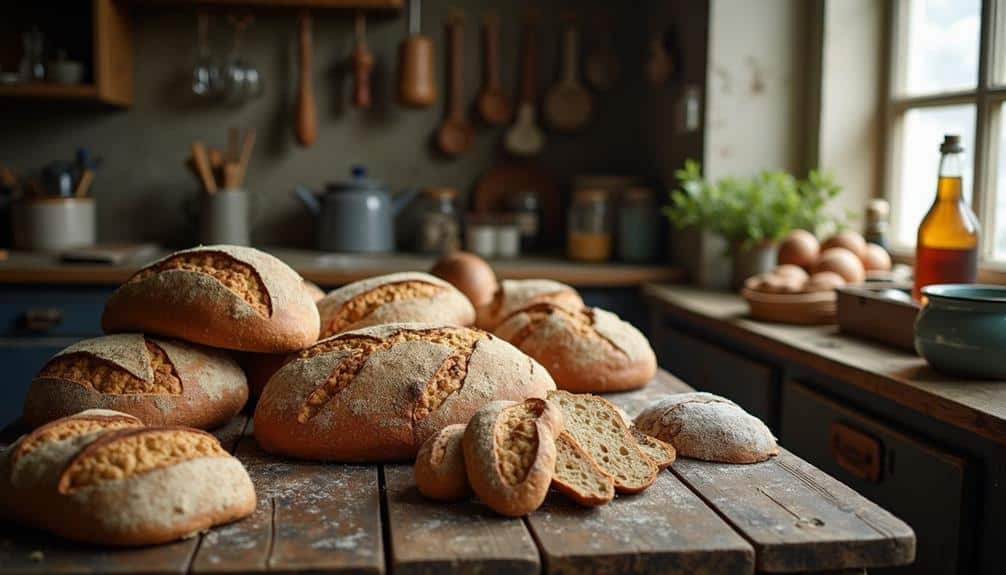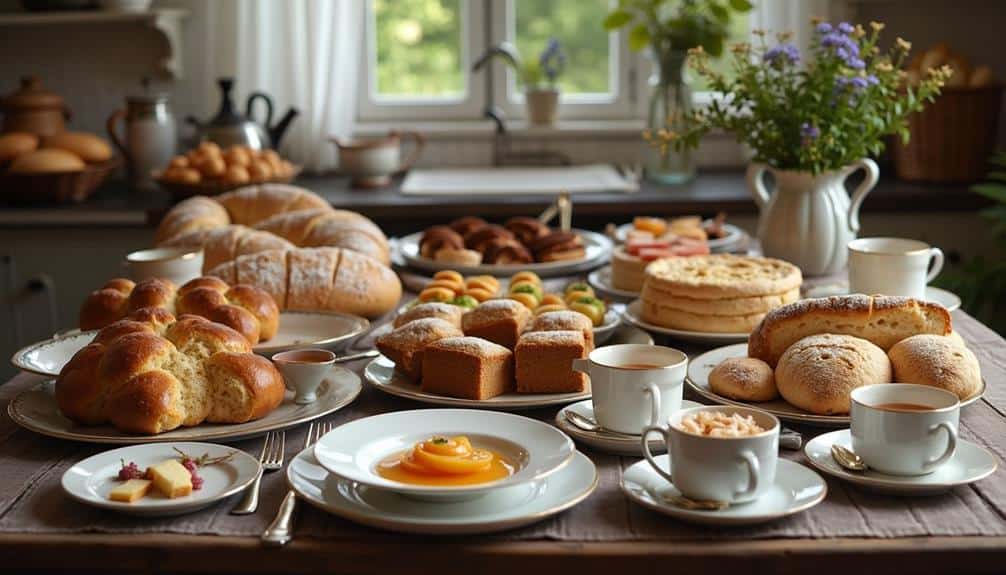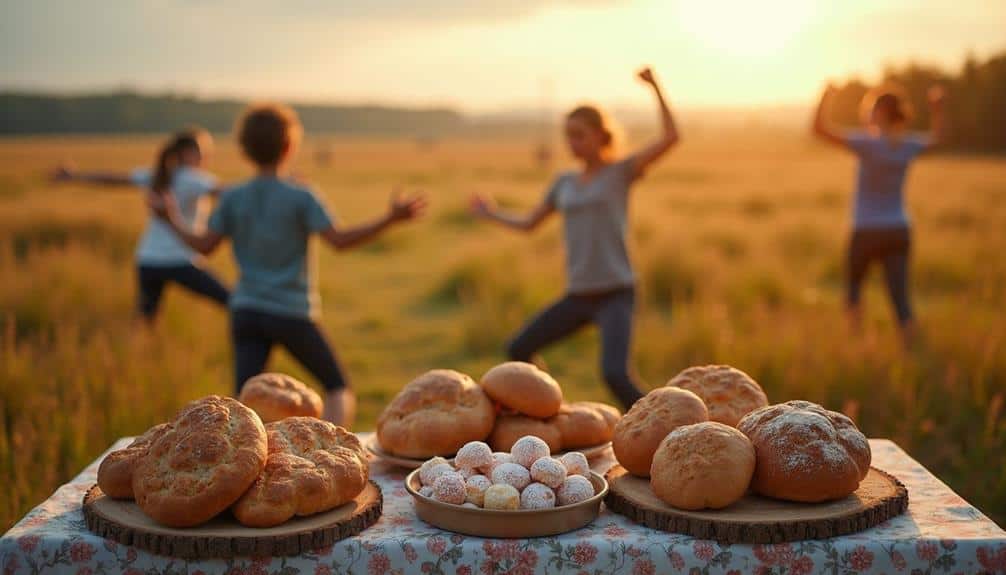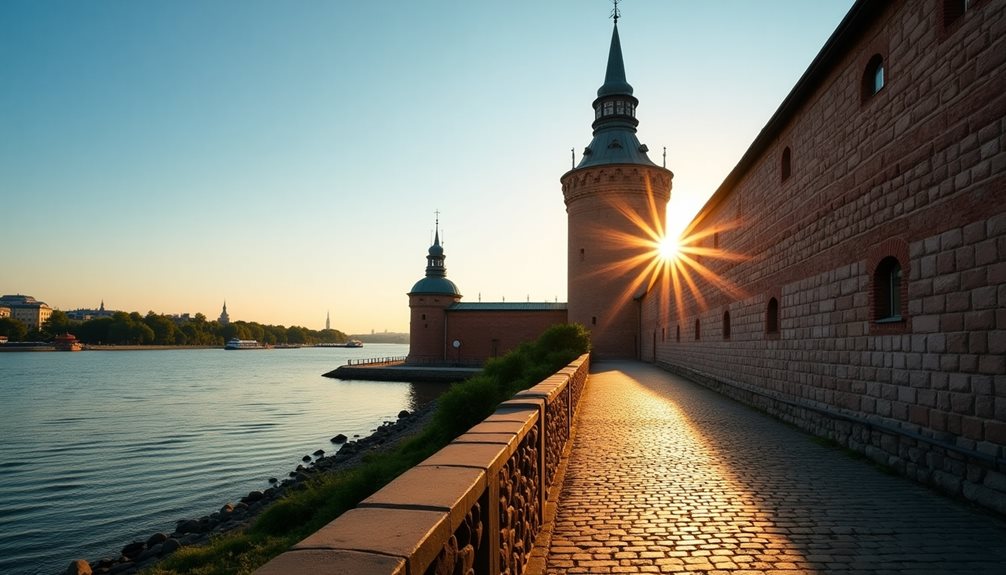Exploring the balance between bread and sweets in Russian cuisine offers a fascinating glimpse into the nation’s dietary secrets. With traditional rye breads like Borodinsky playing a pivotal role and indulgent desserts such as honey cakes and chocolate babka providing a sweet counterpoint, the interplay between these elements is intriguing. The nutritional boost of sourdough and the seasonal ingredients in sweets highlight a mindful approach to eating. Furthermore, the practice of portion control guarantees that indulgence does not lead to excess. What techniques allow Russians to maintain such a harmonious relationship with food?
Traditional Russian Breads

Traditional Russian breads form a cornerstone of the nation’s culinary heritage, reflecting centuries of agrarian traditions and cultural influences. The country’s bread-making practices are deeply rooted in the use of rye, a resilient grain well-suited to Russia’s harsh climate. Various rye varieties play an essential role in creating the distinct flavors and textures that define Russian bread.
One of the most notable features of traditional Russian bread is the emphasis on sourdough traditions. Sourdough starters, often passed down through generations, impart a unique tangy flavor and chewy texture to the bread. This method not only enhances the taste but also improves the bread’s nutritional profile by making it easier to digest and increasing its shelf life.
Among the celebrated types of Russian rye bread is Borodinsky, characterized by its dark color and aromatic blend of coriander and molasses.
Another popular variety is the dense and flavorful black bread, or “Chorny Khleb,” which is a staple in many Russian households. These breads are typically enjoyed with an array of accompaniments, from hearty soups to simple spreads, illustrating the integral role that traditional Russian breads play in daily life and culinary customs.
Popular Russian Sweets
Celebrating the rich tapestry of Russian cuisine, popular Russian sweets offer a delightful glimpse into the country’s penchant for unique and flavorful desserts. Among the most beloved are honey cakes, known locally as “medovik.” These multilayered confections are infused with the rich, natural sweetness of honey, creating a harmonious blend of flavors and textures.
Each layer of honey cake is meticulously prepared, often with a creamy filling that accentuates the honey’s natural warmth.
Another quintessential Russian sweet is chocolate babka, a braided bread that marries the robustness of chocolate with the airy, soft texture of a traditional babka. This treat often features swirls of dark chocolate and is occasionally sprinkled with nuts, providing a satisfying crunch.
Sweet dumplings, or “vareniki,” filled with fruit preserves, are a staple in many Russian households. These dumplings, typically boiled and sometimes lightly fried, offer a burst of fruity sweetness with each bite, making them a versatile dessert that can also serve as a sweet main course.
Fruit preserves themselves are a cherished element of Russian sweets, often used as fillings or accompaniments to other desserts. Whether spread on bread or used in pastries, these preserves capture the essence of seasonal fruits, preserving their flavors for enjoyment throughout the year.
Portion Control Techniques

Effective portion control techniques are integral to maintaining a balanced diet and ensuring nutritional adequacy. In Russian dietary practices, mindful eating and appropriate plate size play essential roles in this regard. Mindful eating emphasizes the importance of being present while consuming food, allowing individuals to savor each bite and recognize satiety cues. This practice helps prevent overeating and promotes a healthier relationship with food.
One effective method involves using smaller plate sizes. Research indicates that people tend to eat less when food is served on smaller plates, as it creates the illusion of a fuller plate. This visual trick helps control portion sizes without feeling deprived. Russians often employ this technique by using smaller bowls and plates for their meals, which naturally limits the amount of food consumed at one time.
Additionally, serving meals in multiple small courses instead of a single large portion can aid in portion control. This method encourages slower eating and provides the body with adequate time to signal fullness.
Seasonal Eating Habits
Seasonal eating habits are a cornerstone of Russian dietary practices, deeply rooted in both cultural and environmental factors. The cyclical nature of the seasons dictates the availability of various ingredients, leading to a diet rich in seasonal ingredients.
During the long winter months, preserved foods such as pickled vegetables and fermented products are staples, guaranteeing nutrition when fresh produce is scarce. Conversely, the arrival of spring and summer brings a bounty of fresh fruits, vegetables, and herbs, which are keenly incorporated into daily meals.
Harvest festivals, such as the traditional “Maslenitsa” in early spring, celebrate the end of winter and the beginning of the growing season. These festivals are not only a time for communal feasting but also an opportunity to honor the cyclical patterns of nature and the hard work of farmers.
The emphasis on seasonal ingredients during these times underscores the importance of locally sourced produce, which is believed to offer superior taste and nutritional benefits.
This adherence to seasonal eating guarantees that the Russian diet remains varied and balanced throughout the year, contributing to overall health and well-being. By aligning dietary practices with the natural rhythm of the seasons, Russians maintain a deep connection to their environment and cultural heritage.
Incorporating Exercise

Incorporating exercise into daily life is a fundamental aspect of maintaining a healthy lifestyle in Russia. This holistic approach to well-being is deeply rooted in cultural practices that value physical activity as much as balanced eating. Traditional exercise routines, such as morning calisthenics known as “зарядка,” are widely practiced across all age groups. These routines typically involve a combination of stretching, light aerobic exercise, and flexibility drills, designed to invigorate the body and mind.
Outdoor activities also play a significant role in Russian exercise habits. The country’s vast natural landscapes offer ample opportunities for hiking, skiing, and swimming, which are often enjoyed as family activities. These activities not only provide physical benefits but also foster social connections and a sense of community.
Ice skating, a popular pastime in the winter months, serves as both a recreational activity and an effective cardiovascular workout.
Furthermore, organized sports and communal fitness classes are increasingly becoming a part of urban life. Yoga, pilates, and martial arts classes are gaining popularity, reflecting a blend of traditional and modern exercise routines.





